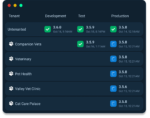
Octopus Deploy this week announced the strengthening of its Kubernetes deployment capabilities to simplify deployments at scale without having to revisit how organizations progress from development to test to production.
“The current buzz around the Kubernetes community is, it seems, like we’re trying to refigure out how to do dev to test to production deployments,” Colin Bowern, senior vice president of product at Octopus Deploy, told SD Times. “A lot of the original sets of tools were really good at doing very simple deployments, and were missing a lot of these concepts. so we’ve made it a lot easier to continue doing what your developers are used to, which is orderly progression from dev to test to production, with all the rules and check and balances along the way. You don’t need to come up with new terms for what was environmental progression.”
Octopus Deploy features support observability, GitOps and environmental progression that the company said makes it easy to model deployments. In a statement, Octopus CEO Paul Stovell said, “Octopus Deploy provides enterprises with a deployment platform designed to simplify and accelerate the delivery of applications at scale, whether you deploy to Kubernetes or not.”
The platform addresses the complexities of scaling deployments to multiple environments with differing applications and requirements by enabling modeling promotions for multiple environments or tenants and by providing configuration templates for setup and deployment. This, the company said in its announcement, includes built-in steps for Kustomize, Helm and plain YAML, as well as sourcing configurations from Git.
Another key feature Octopus Deploy is bringing to cloud computing is the Kubernetes Object Status feature, which provides updates during deployment to allow teams to verify the status of objects and detect deployment errors earlier on.
Bowern noted that in a machine world, you could check in on your deployment process to see if each step worked successfully. But in Kubernetes, you send a manifest and then the cluster performs steps. “So,” he said, “you’re sitting there, trying to figure out, did it work? Did it work?” The object status allows you to watch the deployment, and it flags you immediately if something fails. “You don’t have to sit there at the command line hitting COOP control status, status, status view… kind of just constantly rewriting a command,” he added. “It’s like the UI that Kubernetes never had for deployments. It’s really about trying to bring Kubernetes deployments to the rest of the application teams in the organization with all the controls and all of the safety that’s needed at enterprise scale.”








